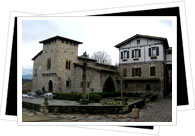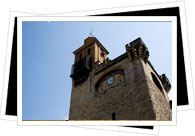Both Renaissance architecture and Baroque art and architecture began in Italy, the Renaissance beginning in the 15th century and the Baroque in the 17th.
The Renaissance, which was just as much an artistic movement as it was an intellectual one, was essentially a revival of the ideals of ancient Rome and Greece. In architecture, the Renaissance manifested itself through a return to the forms and ideals that define Greek and Roman architecture of long ago: columns, simple shapes like triangles and semi-circles, and harmony and symmetry.
 The Renaissance's most famous contributions to Pamplona's cityscape are not religious in nature, but rather military: the defensive walls that once entirely surrounded the city and the Ciudadela, the city's vast, star-shaped citadel. Both were part of Spanish king Felipe II's plan to build up Pamplona's defensive abilities, seeing the city - located in the Pyrenees foothills and close to the French border - as a key military stronghold against unwanted forces coming over the mountains. The Ciudadela was designed by an Italian military architect in tune with his home country's most modern theories on military architecture.
The Renaissance's most famous contributions to Pamplona's cityscape are not religious in nature, but rather military: the defensive walls that once entirely surrounded the city and the Ciudadela, the city's vast, star-shaped citadel. Both were part of Spanish king Felipe II's plan to build up Pamplona's defensive abilities, seeing the city - located in the Pyrenees foothills and close to the French border - as a key military stronghold against unwanted forces coming over the mountains. The Ciudadela was designed by an Italian military architect in tune with his home country's most modern theories on military architecture.
 The subsequent Baroque period was a reaction to the strict, classical forms that defined the Renaissance; curves, twisting columns and sumptuous decoration replaced the rigid forms of the previous centuries. Baroque architecture was not very much a structural style, but rather focused on surface decoration that was meant to appeal to the eye. This worked out well for Pamplona because frankly there was no more room come the 17th and 18th centuries to construct many more new buildings. Instead, the Baroque period often manifests itself in the form of façades.
The subsequent Baroque period was a reaction to the strict, classical forms that defined the Renaissance; curves, twisting columns and sumptuous decoration replaced the rigid forms of the previous centuries. Baroque architecture was not very much a structural style, but rather focused on surface decoration that was meant to appeal to the eye. This worked out well for Pamplona because frankly there was no more room come the 17th and 18th centuries to construct many more new buildings. Instead, the Baroque period often manifests itself in the form of façades.
Examples of Baroque architecture in Pamplona include the Ayuntamiento (City Hall) and several noble homes flanking streets like Zapatería, San Antón, San Nicolás, Estafeta and Mayor.